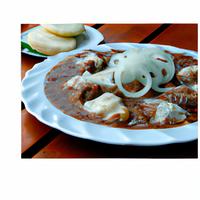
1 serving (30 grams) contains 150 calories, 3.0 grams of protein, 10.0 grams of fat, and 15.0 grams of carbohydrates.

Log this food in SnapCalorie

Nutrition Information
Calories |
1200 | ||
|---|---|---|---|
% Daily Value* |
|||
| Total Fat | 80.0 g | 102% | |
| Saturated Fat | 16.0 g | 80% | |
| Polyunsaturated Fat | 0 g | ||
| Cholesterol | 0 mg | 0% | |
| Sodium | 1600.0 mg | 69% | |
| Total Carbohydrates | 120 g | 43% | |
| Dietary Fiber | 8.0 g | 28% | |
| Sugars | 0 g | ||
| protein | 24 g | 48% | |
| Vitamin D | 0 mcg | 0% | |
| Calcium | 80.0 mg | 6% | |
| Iron | 4.0 mg | 22% | |
| Potassium | 400.0 mg | 8% | |
* Percent Daily Values are based on a 2,000 calorie diet. Your daily values may be higher or lower depending on your calorie needs.
Food Attributes
Source of Calories
About Karasev
Karasev is a crispy, savory snack originating from South Indian cuisine, often enjoyed during festive occasions or as a teatime treat. Made from a base of chickpea flour (besan) and rice flour, it is seasoned with a mix of spices such as black pepper, red chili powder, and sometimes garlic, lending a bold and flavorful taste. The dough is shaped into thin strands and deep-fried until golden brown, creating a crunchy texture. While Karasev is gluten-free and provides some protein from chickpea flour, it is typically high in calories and fat due to frying. Enjoyed in moderation, it can be a satisfying addition to a balanced snack repertoire, but those watching fat intake or managing heart health might prefer baked alternatives. A traditional favorite, Karasev reflects India’s knack for turning simple ingredients into irresistible, spiced delights.



